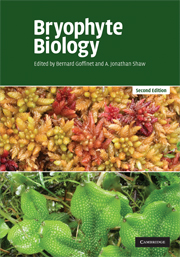Book contents
- Frontmatter
- Contents
- List of contributors
- Preface
- 1 Morphology and classification of the Marchantiophyta
- 2 Morphology, anatomy, and classification of the Bryophyta
- 3 New insights into morphology, anatomy, and systematics of hornworts
- 4 Phylogenomics and early land plant evolution
- 5 Mosses as model organisms for developmental, cellular, and molecular biology
- 6 Physiological ecology
- 7 Biochemical and molecular mechanisms of desiccation tolerance in bryophytes
- 8 Mineral nutrition and substratum ecology
- 9 The structure and function of bryophyte-dominated peatlands
- 10 Population and community ecology of bryophytes
- 11 Bryophyte species and speciation
- 12 Conservation biology of bryophytes
- Index
- References
1 - Morphology and classification of the Marchantiophyta
Published online by Cambridge University Press: 06 July 2010
- Frontmatter
- Contents
- List of contributors
- Preface
- 1 Morphology and classification of the Marchantiophyta
- 2 Morphology, anatomy, and classification of the Bryophyta
- 3 New insights into morphology, anatomy, and systematics of hornworts
- 4 Phylogenomics and early land plant evolution
- 5 Mosses as model organisms for developmental, cellular, and molecular biology
- 6 Physiological ecology
- 7 Biochemical and molecular mechanisms of desiccation tolerance in bryophytes
- 8 Mineral nutrition and substratum ecology
- 9 The structure and function of bryophyte-dominated peatlands
- 10 Population and community ecology of bryophytes
- 11 Bryophyte species and speciation
- 12 Conservation biology of bryophytes
- Index
- References
Summary
Introduction
Liverworts are a diverse phylum of small, herbaceous, terrestrial plants, estimated to comprise about 5000 species in 391 genera. They occupy an assortment of habitats, including disturbed soil along stream banks, road cuts and trails, as well as rocks, logs and trees in natural landscapes. They occur on all continents, including Antarctica, but are most diversified in the montane rain forests of the southern hemisphere. Many species are quite tolerant of repeated cycles of drying and wetting (Clausen 1964, Wood 2007), a feature that has allowed them also to exploit epiphytic substrates, including leaves and branches of the forest canopy. Like mosses and hornworts, they have a heteromorphic life cycle with a sporophyte that is comparatively short-lived and nutritionally dependent on the free-living, usually perennial gametophyte. However, they differ from both of these groups in numerous cytological, biochemical, and anatomical features as detailed by Crandall-Stotler (1984). Significant diagnostic characters of the phylum include the following: they tend to have a flattened appearance, even when leafy, because their leaves are always arranged in rows, never in spiral phyllotaxis; rhizoids are unicellular, thin-walled, and usually hyaline; both leafy and thalloid forms frequently develop endosymbiotic associations with fungi; sporophytes mature completely enclosed by gametophytic tissue and are incapable of self-sustaining photosynthesis; sporophyte setae are parenchymatous and elongate by cell expansion, rather than cell division; and capsules lack the stomates, cuticle, and columella that are common in mosses and hornworts.
- Type
- Chapter
- Information
- Bryophyte Biology , pp. 1 - 54Publisher: Cambridge University PressPrint publication year: 2008
References
- 35
- Cited by



